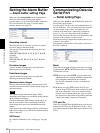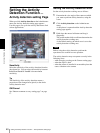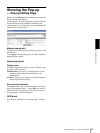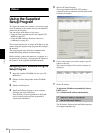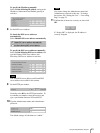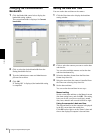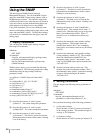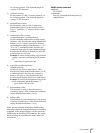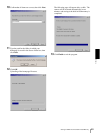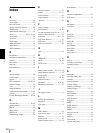
Others
Using the SNMP
46
Using the SNMP
This unit supports SNMP (Simple Network
Management Protocol). You can read MIB-2 objects
and write some MIB-2 objects using software such as
SNMP manager software. This unit also supports the
coldStart trap which occurs when the power is turned on
or the unit restarts, and the Authentication failure trap
which informs of an illegal access using SNMP.
Using CGI commands, you can set community name
and access limitation, reading/writing right, host to send
traps, and some MIB-2 objects. To allow these settings,
you need Level 4 authentication (the right to open the
setting pages).
1. Inquiry Commands
You can check the SNMP Agent settings using the
following CGI commands.
<Method>
GET, POST
<Command>
“http://ip_adr/snmpdconf/inquiry.cgi?inqjs=snmp
(JavaScript parameter format)
http://ip_adr/snmpdconf/inquiry.cgi?inq=snmp
(standard format)
With the above inquiry, you can obtain the following
setting information. The following explains the setting
information using the inqjs=snmp (JavaScript
parameter) format.
var sysDescr=“\“SONY Network Camera SNC-
CS3\”” ...1
var sysObjectID=“1.3.6.1.4.1.122.8501” ...2
var sysLocation=“\“\”” ...3
var sysContact=“\“\”” ...4
var sysName=“\“\”” ...5
var snmpEnableAuthenTraps=“1” ...6
var community=“public,0.0.0.0,read,1” ...7
var community=“private,192.168.0.101,write,2” ...8
var trap=“public,192.168.0.101.1” ...9
1 describes the instance of “mib-2.system.
sysDescr.0”. You cannot change this parameter.
2 describes the instance of “mib-2.system.
sysObjectID.0”. You cannot change this parameter.
3 describes the instance of “mib-2.system.
sysLocation.0”. This field is used to describe the
information on the location of this camera. Nothing
is set at the factory.
4 describes the instance of “mib-2.system.
sysContact.0”. This field is used to describe the
information on the administrator of this camera.
Nothing is set at the factory.
5 describes the instance of “mib-2.system.
sysName.0”. This field is used to describe the
administration node of this camera. Nothing is set
at the factory.
6 describes the instance of “mib-2.snmpEnable
AuthenTraps.0”. This example shows when “1”
(enable) is set. With this setting, a trap occurs when
there is an Authentication failure. When “2”
(disable) is set, no Authentication failure trap
occurs.
7 describes the community name and the reading/
writing attributes. This example shows the
identification number “ID=1”, the community
name public, and enables read from any IP address
(0.0.0.0).
8 describes the community name and the reading/
writing attributes, similarly to 7. This example
shows the identification number ID=2, the
community name “private”, and enables “read/
write” by the SNMP request packet from the host
“192.168.0.101”.
9 describes the host name to send a trap. This
example shows the identification number “ID=1”,
the community name “public”, and enables sending
of traps to the host having the IP address
“192.168.0.101”.
2. Setting Commands
The unit supports the following setting commands of
SNMP.
<Method>
GET, POST
<Command>
http://ip_adr/snmpdconf/snmpdconf.cgi?
<parameter>=<value>&<parameter>=...&...
First, perform the settings of the following parameters.
1) sysLocation=<string>
Set the instance of “mib-2.system.sysLocation.0”
in the <string> position. The maximum length of
<string> is 255 characters.
2) sysContact=<string>
Set the instance of “mib-2.system.sysContact.0” in




